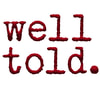Published by Black Ink Books, October 2021 | Non-fiction, Australian, Women It’s impossible not to be moved by Currowan, the debut book by award-winning journalist Bronwyn Adcock.
It is a gripping account of the monstrous bushfire on the South Coast of New South Wales that lasted for more than 70 days, killing three and incinerating homes and wildlife across nearly 5000 square kilometres – one of many bushfires that paralysed Australia during the summer of 2019-20. Adcock evokes a vivid sense of the heart-hammering fear, bravery, trauma and community spirit shared by most families in the region, including her own, in the face of a fire described at a coronial inquest last month as ‘extreme, abnormal and unlike any other’. But her book goes beyond just retelling survivors’ agonising personal experiences. Putting her 25 years of experience as an investigative journalist to work, she also explores important questions about Australia’s preparedness for the more dangerous world we have entered, in which the behaviour of bushfires like Currowan will challenge our traditional understanding, far outstripping our capacity to fight them. Adcock does not shy away from critiquing authorities’ response to the fire. Drawing on first-hand accounts from impacted residents, firefighting crews and community leaders, she asks tough questions around decisions taken during the emergency, and calls out flaws that hampered firefighting efforts, some possibly putting lives at higher risk. Adcock begins her story on the last day of 2019, a few weeks after her family’s 40-acre property, around 20 kilometres south of Ulladulla, was engulfed by Currowan’s raging flames. Her husband, an experienced RFS volunteer who had stayed to defend their home, was lucky to have been pulled out alive by his equally courageous RFS mates. It’s 3 a.m. and she suddenly wakes in her temporary accommodation, heart racing – a regular experience for her since the fire began its rampage from a lightning strike at the end of November. ‘Often nothing in particular rouses me,’ she writes, ‘only a feeling of vigilance: I’m ready … But most of the time, what wakes me is fear of what this still-burning fire will do next.’ This dread of the fire’s capriciousness – its ‘freakish’ behaviour taking even experienced firefighters by surprise – becomes a strong theme throughout Adcock’s story. Using meticulous scientific detail, she builds up our understanding of the ‘rules’ the fire broke – such as spreading quickly at night, advancing against the wind, spawning spot fires many kilometres ahead of itself, and creating more fire-generated thunderstorms – or pyrocumulonimbus events – than ever before. Alongside her technical insights, Adcock’s retelling of survivors’ accounts also conjures a sense of the fire as a living, breathing, lurking beast – hiding silently, then ferociously striking without warning – amplifying the malevolence of the ‘big red fire dragon’, as it was described by one survivor. Yet despite the seemingly uncontainable nature of the raging fire, fuelled by drought conditions and the highest temperatures on record, Adcock rolls out many well-researched facts that show the intensity of the fires shouldn’t have been a surprise. This includes a 2008 report commissioned by the Australian government that predicted these types of conditions ‘should be directly observable by 2020’. Adcock’s inference is clear: the country should have been better prepared. The heart of Adcock’s book lies in the personal stories of the dozens of survivors she interviewed, crystalising their thrumming anxiety, quick thinking and harrowing escapes. Survivors like the woman who was blocked from returning by road to her husband, who had Parkinson’s disease, as the fire headed towards their Lake Conjola home. She resorted to trekking eight kilometres along the beach and swimming through the inlet to get to him, navigating choking black smoke and kangaroos in flames desperately jumping into the safety of the water. Or the couple on the phone to their son, as he told them he’d become trapped in their burning family home encircled by the firestorm, while on the other line emergency services were telling them they had no resources to help. Then there are Adcock’s uplifting accounts of powerful community spirit, including residents opening their doors to strangers who’d lost their homes, the circus offering generators to light up community halls that had lost power and were serving as evacuation centres, and the village publicans who sheltered the locals as their homes exploded in flames. Adcock’s investment in capturing these stories and their ramifications is clear – not only for her own community on the South Coast, where she grew up and to which she returned around 10 years ago after building her career reporting on global and local current affairs, including for ABC and SBS. It is also a stark warning to every community throughout Australia – and the world – that Black Summer was not a one-off event. The evidence she provides – from decades of scientific forecasts reiterated in the recent Bushfires Royal Commission and NSW Bushfire Inquiry – shows more catastrophic fires are inevitable as the climate changes. And, as the Currowan fire proved, the methods of the past cannot be relied on to fight the changing fires of the future. It’s these warnings, coupled with Adcock’s insights into how the nation might become better prepared, that make this book so important. Currowan by Bronwyn Adcock Published by Black Inc. 2021 Comments are closed.
|
Categories
All
Archives
May 2024
|

